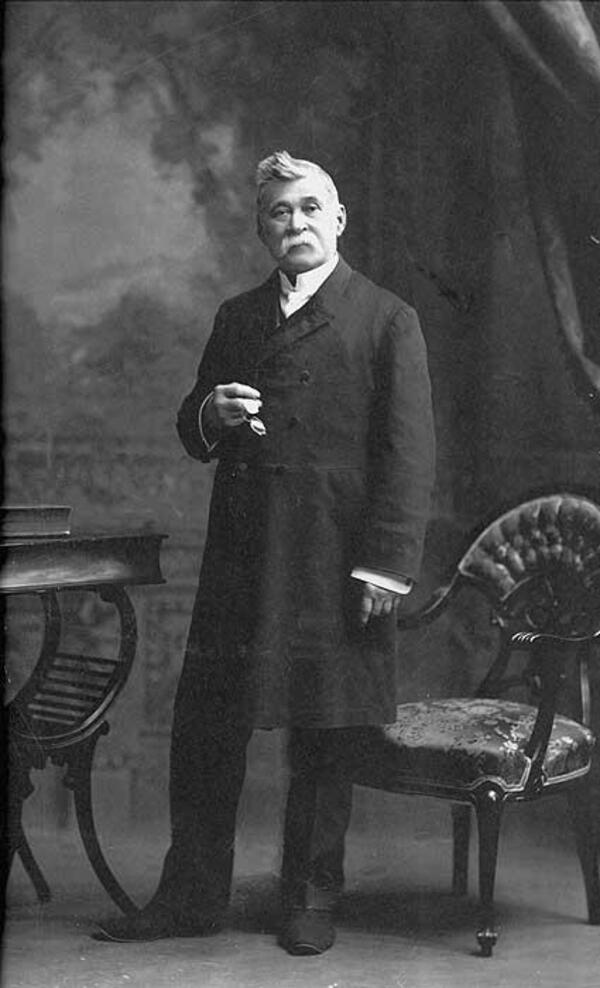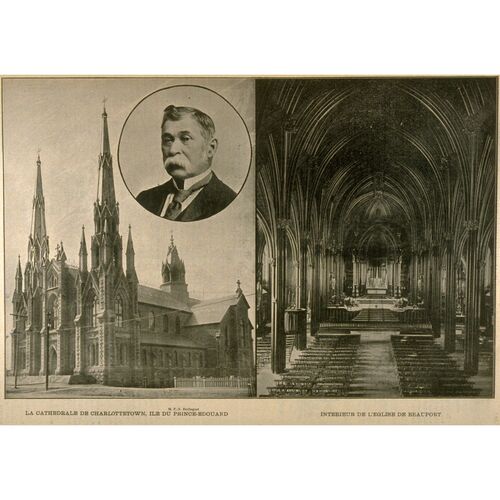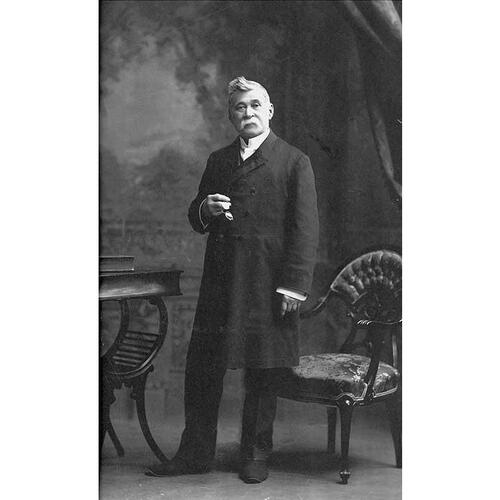
Source: Link
BERLINGUET, FRANÇOIS-XAVIER (baptized Antoine-François-Xavier), wood-carver, civil engineer, and architect; b. 4 Dec. 1830 at Quebec, son of Louis-Thomas Berlinguet and Marie-Charlotte Maillou; m. there 12 June 1854 Marie-Flore Allard, and they had four children; d. 3 Aug. 1916 in Trois-Rivières, Que.
François-Xavier Berlinguet learned the rudiments of wood-carving and ornamental architecture at a young age from his father, Louis-Thomas, a carver of statues and gilder trained in the Montreal region in the tradition of Louis Quévillon*. He completed his architectural studies with Thomas Baillairgé* and then with Charles Baillairgé*. From 1852 he was head of an architectural and contracting agency at Quebec. His early commissions drew primarily on his initial training as a carver. For example, he created the interior décor for many churches in the vicinity of Quebec City and in the lower St Lawrence region, including those at Cacouna (1852–53), Beauport (1857, or perhaps 1856), Saint-Pascal (1857), Château-Richer (1864), and Saint-François-de-Sales-de-la-Rivière-du-Sud (Saint-François-de-la-Rivière-du-Sud). In 1860 he was awarded a medal for the Ecce Homo he carved for the church at Beauport, which was displayed at an exhibition in Montreal during the Prince of Wales’s visit. Berlinguet did a number of carvings for Charles Baillairgé, including the archiepiscopal throne for Notre-Dame cathedral at Quebec, the tabernacle for the high altar in the chapel of the Sœurs de la Charité de Québec, and the altars for the church of Sainte-Marie in Beauce. In 1865 a terrible fire ravaged his workshop and the carvings in it, including those for the interior of the church at L’Ancienne-Lorette, which were ready for delivery.
Berlinguet’s career took a significant turn in 1870, when he was involved in building a large section of the Intercolonial Railway, the line which was to connect Nova Scotia and New Brunswick with the province of Quebec. The time he spent in the Atlantic provinces enabled him to widen his business network and to build up a clientele there whose loyalty he would retain for years. On his return to Quebec he opened an architectural and civil engineering business. Although he worked mainly as a contractor, architect, and carver, he submitted numerous plans that revealed his interest in new trends and in urban progress, including one in 1875 for improving the port and constructing a double pier in the estuary of the Rivière Saint-Charles. Although for many reasons, both political and economic, they were not pursued, some of Berlinguet’s ideas may be considered the point of departure for later works, such as the construction of a railway bridge across the St Lawrence. His reputation as a civil engineer extended to Trois-Rivières, where in 1887 he was awarded a contract to install the city’s water and sewer systems.
Berlinguet spent nearly six months travelling in Europe in 1891. When he returned, René-Pamphile Lemay began architectural training in his office as clerk of works, and he became Berlinguet’s chief partner in 1896. From then on, the firm of Berlinguet et Lemay undertook major projects in the Maritimes and in the province of Quebec at the same time. Among the most important were a wing for the Prince Edward Island legislative building, the cathedrals in Charlottetown and in Chatham, N.B., the Roman Catholic churches in Tracadie, Mont Carmel, Kinkora, and Souris, P.E.I., the rebuilding of the church in Beauport, Que., and numerous schools, asylums, and residences. In 1897, to meet the new needs of the city of Quebec, the agency submitted an original plan for a multi-purpose building that would include a conservatory of music, two concert halls, offices, and shops. The proposal was not accepted, but shortly afterwards promoters brought in an American architect to build the Auditorium de Québec (now the Théâtre Capitole), and Berlinguet et Lemay supervised the construction.
Berlinguet’s main clients at Quebec were the parish fabriques and the religious communities. For the Ursulines, the architect drew up plans for a convent in Stanstead (1883) and a sacristy on Rue Donnacona featuring a picturesque stairway turret (1889). For the Franciscan Missionaries of Mary, he designed a chapel on Grande Allée (1898), which is the finest example of neo-baroque décor at Quebec. He also did the plans for the St Vincent de Paul Society’s Œuvre du Patronage (1895), a place which provided care and Christian education to poor children, and for the Franciscan convent (1901), extensions to the church (1909) and to a convent (1910) of the Sisters of the Good Shepherd, the chapel of the Missionnaires du Sacré-Cœur on Rue Sainte-Ursule (1909) (a replica of Notre-Dame-du-Sacré-Cœur in Issoudun, France), and a false façade and a wing for the episcopal palace on Rue Port-Dauphin (1903).
In the secular field, Berlinguet distinguished himself in 1880 by winning second prize for his plans for the legislative buildings in Toronto, in competition with 15 other Canadian and American architects [see Kivas Tully*]. In 1883 he began supervising work on the interior ornamentation of the Quebec legislative building, which was noteworthy both for the plaster mouldings that decorated its main halls and for the carving and gilding on its woodwork in general. In 1887 he was appointed official judge of public works done for the Quebec government. He was a founding member of the Province of Quebec Association of Architects and served as its president in 1891–92. He also belonged to the Geographical Society of Quebec, of which he was president in 1906, the Quebec Board of Trade, and the Institut Canadien de Québec.
Berlinguet’s architecture bears witness to his preference for skilfully composed carved forms. On the whole, his projects were typical of the eclectic spirit of the second half of the 19th century. Although he favoured the neo-gothic or neo-baroque in religious architecture, to satisfy a diverse clientele Berlinguet drew inspiration from every style when it came to residential architecture. Because of his threefold training, in carving, civil engineering, and architecture, he was able to undertake and supervise the most varied projects at all stages of their development. His father and his brother Louis-Flavien were known mainly as carvers, but François-Xavier used his wider expertise in general contracting, and thus succeeded both as an artist and as a businessman. His professional life, which spanned nearly 60 years, was extremely busy. Architects René-Pamphile Lemay and David Ouellet, as well as carvers Louis Jobin*, Narcisse Bertrand, and Jean-Baptiste Côté*, were his students.
AC, Québec, Minutiers, J.-A. Charlebois, 23 mars 1889, 1er mars 1898; Joseph Sirois, 9 août 1909; Cyrille Tessier, 16 avril 1895, 27 avril 1909, 6 juin 1910. ANQ-M, P-543/1/5/1. ANQ-Q, CE1-1, 5 déc. 1830; CE1-22, 12 juin 1854; CN1-139, 27 août 1852, 26 mai 1856; CN1-180, 6 juin 1883; CN1-234, 31 oct. 1857; M 186/03273, 03278, 03325, 03360; P-372/214/1. Arch. de la Ville de Québec, P00873-001 (Topographical plan, city of Quebec and village St-Sauveur). Le Courrier du Canada (Québec), 6 août 1860. Le Journal de Québec, 8 mai 1856, 24 juill. 1862, 17 mars 1863, 15 avril 1865, 25 juin 1868, 10 févr. 1886, 8 août 1887. La Minerve, 13 juin 1883. La Semaine commerciale (Québec), 27 mars, 24 juill. 1896; 15 avril 1897; 13 mai 1898; 12 févr. 1904. Le Soleil, 7 août 1916. Marius Barbeau, Au cœur de Québec (Montréal, 1934). Canadian album (Cochrane and Hopkins), 5: 73. Canadian Architect and Builder (Toronto), 4 (1891): 31, 89. Institut Canadien de Québec, Annuaire, 1874–88. Karel, Dict. des artistes. Luc Noppen et al., Québec: trois siècles d’architecture ([Montréal], 1979). J. R. Porter et Jean Bélisle, La sculpture ancienne au Québec; trois siècles d’art religieux et profane (Montréal, 1986). A. J. H. Richardson et al., Quebec City: architects, artisans and builders (Ottawa, 1984), 101. A.-B. Routhier, Québec et Lévis à l’aurore du XXe siècle (Montréal, 1900).
Cite This Article
Denyse Légaré, “BERLINGUET, FRANÇOIS-XAVIER (baptized Antoine-François-Xavier),” in Dictionary of Canadian Biography, vol. 14, University of Toronto/Université Laval, 2003–, accessed January 1, 2026, https://www.biographi.ca/en/bio/berlinguet_francois_xavier_14E.html.
The citation above shows the format for footnotes and endnotes according to the Chicago manual of style (16th edition). Information to be used in other citation formats:
| Permalink: | https://www.biographi.ca/en/bio/berlinguet_francois_xavier_14E.html |
| Author of Article: | Denyse Légaré |
| Title of Article: | BERLINGUET, FRANÇOIS-XAVIER (baptized Antoine-François-Xavier) |
| Publication Name: | Dictionary of Canadian Biography, vol. 14 |
| Publisher: | University of Toronto/Université Laval |
| Year of publication: | 1998 |
| Year of revision: | 1998 |
| Access Date: | January 1, 2026 |




